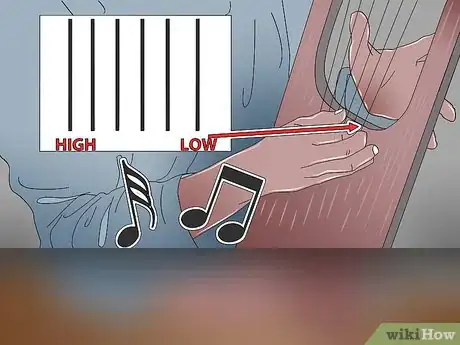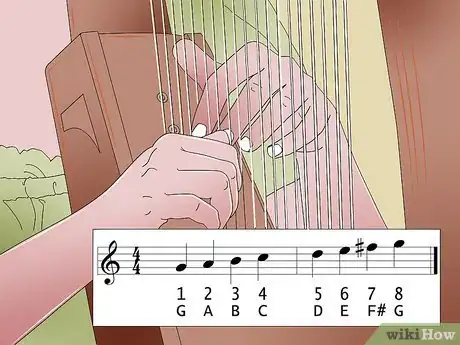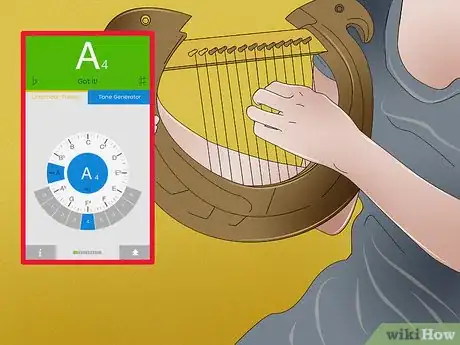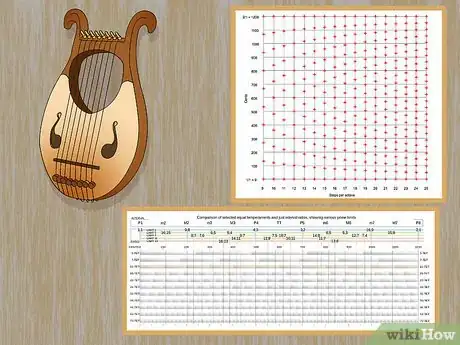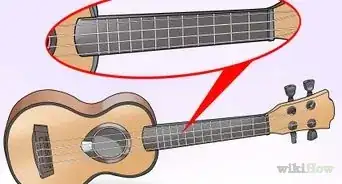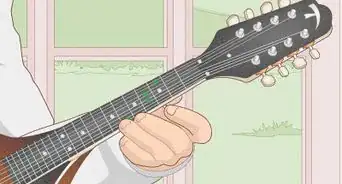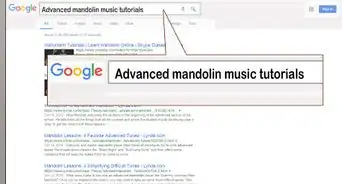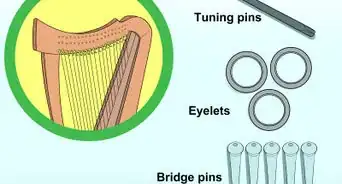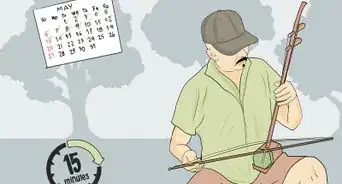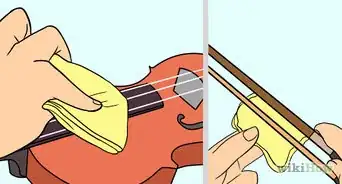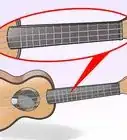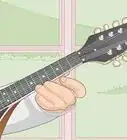wikiHow is a “wiki,” similar to Wikipedia, which means that many of our articles are co-written by multiple authors. To create this article, 19 people, some anonymous, worked to edit and improve it over time.
This article has been viewed 83,277 times.
Learn more...
Lyres are a category of stringed instruments known since the earliest civilizations. The Ancient Greeks and Romans played lyres, and after the fall of Rome the instrument became popular with Celtic and Germanic tribes in Europe.
A lyre is technically different from a harp in that the strings run parallel to the soundboard rather than perpendicular.
Tuning a lyre, though basically simple, can seem overwhelming for beginners, both in technique and in choice of tuning. These instructions apply primarily to the 6-string Anglo Saxon (or "Germanic") lyre, but can also be applied to other six-string lyres, the 5-string Finnish kantele or Russian gusle, and other similar instruments.[1]
Steps
-
1Establish the basic key of your lyre. Do this by tuning your lowest string until it is tense enough to produce a clear note with little/no buzzing, but not so tight that it feels about to break.[2]
-
2Now, pick a tuning appropriate to your needs, but transposed (if necessary) to the key of your lyre. That is, if your deepest string is comfortable at "G", the G equivalent of the CDEFGA tuning would be GABCDE.[3]Advertisement
-
3If you have a modern metal zither pegs, simply turn them with a peg-key to tighten. If you have friction pegs (traditional wooden or bone tapered pegs), push carefully but firmly towards the crosspiece while turning, otherwise the peg will slip after you let it go. If you have trouble turning the peg and getting it to stay, google up "peg dope" for ideas of what materials to use to change the grip of your peg.[4]
-
4To hit the notes of the tuning you've selected, a beginner will probably want to use an online tuner, or a store-bought chromatic tuner or tuner app on a smartphone. If you have a good ear for intervals, you may also be able to tune by ear.[5]
-
5Understand that most tuners are set up to tune by "Equal Temperament", the modern way of tuning where an instrument will sound good in any key, but not quite perfect in any of them. Since a lyre often plays in only one key at a time, consider tuning to "Just Intonation" based around the key note of your lyre. Several of the better smartphone tuners have an option to tune by JI (make sure to designate the keynote of your instrument around which all the tuning will be based).[6]
Community Q&A
-
QuestionWhat is the highest note of the lyre called?
 Community AnswerThe highest note is called the nete.
Community AnswerThe highest note is called the nete. -
QuestionWhat is the note on the fourth string of a 10 string harp?
 George MalenCommunity AnswerThe note on the fourth string is a G (in the key of F). The tuning is (E,F, F#, G, G#, A, A#, B, C, D).
George MalenCommunity AnswerThe note on the fourth string is a G (in the key of F). The tuning is (E,F, F#, G, G#, A, A#, B, C, D). -
QuestionHow often do you need to restring a lyre, more specifically a soprano lyre? It usually has a lot more strings than the authentic one (35-47 strings).
 Community AnswerIt depends. If your instrument is in good shape and the neck is not bent out of shape, you don't need to replace them very often. Depending on how much you play, it can be anything from one week to a couple months. A good rule of thumb is to replace them whenever it gets hard to keep them in tune.
Community AnswerIt depends. If your instrument is in good shape and the neck is not bent out of shape, you don't need to replace them very often. Depending on how much you play, it can be anything from one week to a couple months. A good rule of thumb is to replace them whenever it gets hard to keep them in tune.
6-string lyre tunings
The following tunings are used on the Anglo-Saxon (or Germanic) lyre, but are also possible on other 6-string instruments. The key of C is used in these examples, but for your particular lyre you should tune your strings to whatever pitch is appropriate, and tune to the same intervals as shown.
Popular scales
-
C-D-E-F-G-A, diatonic major or Hucbald tuning (after the 9th C. monk who documented it): this tuning is useful for playing standard melodies such as are common for modern Western music. It's a complete diatonic scale except in that it lacks the 7th, which is arguably the most sacrificable note for most purposes. This tuning also lends itself decently well to playing basic modern chord progressions.
- In G: G-A-B-C-D-E
- In D: D-E-F#-G-A-B
- In A: A-B-C#-D-E-F#
-
C-E♭-F-G-B♭-C, pentatonic minor: Also nicknamed the viking tuning, this tuning is both limiting and liberating, as it's tough to play many modern melodies, but also easy to play 4th and fifth intervals, with a nice octave. No gap between notes is less that a whole step, so this scale is defined as "anhemitonic", and has no "dissonant intervals". Historically-informed musician Ben Bagby uses this tuning for his performances of "Beowulf."
- In G: G-B♭-C-D-F-G
- In D: D-F-G-A-C-D
- In A: A-C-D-E-G-A
-
C-D♭-F-G-A♭-C, Icelandic hemitonic:
- In G: G-A♭-C-D-E♭-G
- In D: D-E♭-G-A-B♭-D
- In A: A-B♭-D-E-F-A
Individuals
Scales used and promoted by individual modern lyre players.
-
C-D-E-F-G-G#, diatonic major diminished 6th?: allows some interesting dissonances, and has an "unearthly" vibe to it.
- In G: G-A-B-C-D-D#
- In D: D-E-F#-G-A-A#
- In A: A-B-C#-D-E-F
Uncommon scales
Many of these scales are variants on the above popular scales. Many are not commonly used on the Anglo Saxon lyre, but present theoretical useful tunings.
- C-D-E♭-F-G-A♭, diatonic minor: similar concept to the diatonic major, with a lowered third and seventh.
-
C-D-E-G-A-C, pentatonic major: Unlike the pentatonic minor, the pentatonic major has no 4th or 7th (which would make it a hemitonic scale) but is anhemitonic like the minor. It sacrifices the fourth of C, but D, E, and G all have fourths available.
- In G: G-B-C-D-F#-G
- In D: D-F#-G-A-C#-D
- In A: A-C#-D-E-G#-A
- C-E-F-G-B-C, hemitonic major: the pentatonic minor scale, with the third and seventh raised to make it a major scale, and now hemitonic.
- C-E♭-F-F♯-G-B♭, minor blues hexatonic: not traditional, but an interesting one to try.
Glossary
- diatonic: a "standard" modern scale going up by half- and full-tones in steps to create a scale. A 6-string lyre does not have enough strings to do a full diatonic scale (7 tones), so will skip one note. Generally those labeled "diatonic" skip the 7th, the final note of the scale.
- pentatonic: a scale with five notes. On a 6-string lyre, a pentatonic scale will have an octave between the lowest and highest strings, since the scale is completed prior to the 6th string.
- hexatonic: a scale with six notes. A 6-string lyre has just enough strings to do a full hexatonic scale, but no high octave.
- hemitonic: a pentatonic scale in which there are some notes with only a half-step gap between them. The opposite of this is anhemitonic, a scale where all notes have at least a full-step between them. Anhemitonic is considered "standard" in pentatonic scales and generally implied vice specified.
Warnings
- As you're tuning up to hit a note, keep checking the tension on your string and see if it's cooked-spaghetti-floppy or cheese-cutter-wire-tight. If so, you probably need to transpose, as above, or consider changing gauges of strings. Playing with all your strings at the breaking point, especially on a steel-strung instrument, can cave in your soundboard.⧼thumbs_response⧽
- If you're a little high, instead of tuning down to your note, tune below it and come back up. It's easy for a string to slip and go of tune as it's sliding down, and you might find your tuning sour 10 seconds later as it adjusts. But if you go below and tune up, it'll stay nice and tight.⧼thumbs_response⧽
